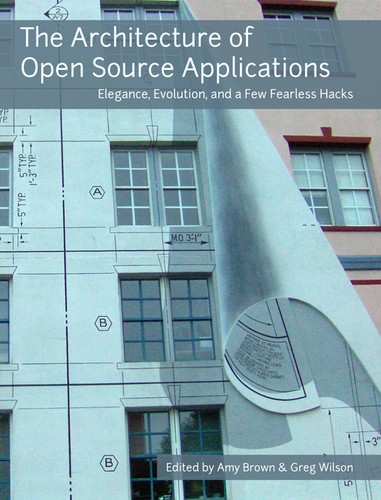
The Architecture of Open Source Applications: Elegance, Evolution, and a Few Fearless Hacks
In this book, the authors of twenty-five open source applications explain how their software is structured, how its parts interact, why it's built that way, and what lessons have been learned that can be applied to other big design problems.
Publication date: 21 Apr 2014
ISBN-10: n/a
ISBN-13: 9781257638017
Paperback: 432 pages
Views: 10,624
Type: Book
Publisher: Lulu.com
License: Creative Commons Attribution 3.0 Unported
Post time: 16 Dec 2016 02:00:00
The Architecture of Open Source Applications: Elegance, Evolution, and a Few Fearless Hacks
 In this book, the authors of twenty-five open source applications explain how their software is structured, how its parts interact, why it's built that way, and what lessons have been learned that can be applied to other big design problems.
In this book, the authors of twenty-five open source applications explain how their software is structured, how its parts interact, why it's built that way, and what lessons have been learned that can be applied to other big design problems.
Publication date: 21 Apr 2014
ISBN-10: n/a
ISBN-13: 9781257638017
Paperback: 432 pages
Views: 10,624
Document Type: Book
Publisher: Lulu.com
License: Creative Commons Attribution 3.0 Unported
Post time: 16 Dec 2016 02:00:00
Share — copy and redistribute the material in any medium or format
Adapt — remix, transform, and build upon the material for any purpose, even commercially.
The licensor cannot revoke these freedoms as long as you follow the license terms.
Click here to read the full license.
Brown and Wilson wrote:Building architecture and software architecture have a lot in common, but there is one crucial difference. While architects study thousands of buildings in their training and during their careers, most software developers only ever get to know a handful of large programs well. And more often than not, those are programs they wrote themselves. They never get to see the great programs of history, or read critiques of those programs' designs written by experienced practitioners. As a result, they repeat one another's mistakes rather than building on one another's successes.
This book is our attempt to change that. Each chapter describes the architecture of an open source application: how it is structured, how its parts interact, why it's built that way, and what lessons have been learned that can be applied to other big design problems. The descriptions are written by the people who know the software best, people with years or decades of experience designing and re-designing complex applications. The applications themselves range in scale from simple drawing programs and web-based spreadsheets to compiler toolkits and multi-million line visualization packages. Some are only a few years old, while others are approaching their thirtieth anniversary. What they have in common is that their creators have thought long and hard about their design, and are willing to share those thoughts with you. We hope you enjoy what they have written.
Tweet
About The Editor(s)
Greg is the founder of Software Carpentry, a crash course in computing skills for scientists and engineers. He has worked for 30 years in both industry and academia, and is the author or editor of several books on computing, including the 2008 Jolt Award winner Beautiful Code and the first two volumes of The Architecture of Open Source Applications. Greg received a PhD in Computer Science from the University of Edinburgh in 1993.

Greg is the founder of Software Carpentry, a crash course in computing skills for scientists and engineers. He has worked for 30 years in both industry and academia, and is the author or editor of several books on computing, including the 2008 Jolt Award winner Beautiful Code and the first two volumes of The Architecture of Open Source Applications. Greg received a PhD in Computer Science from the University of Edinburgh in 1993.
